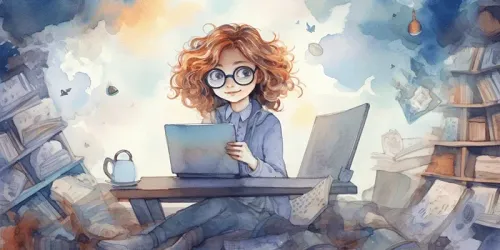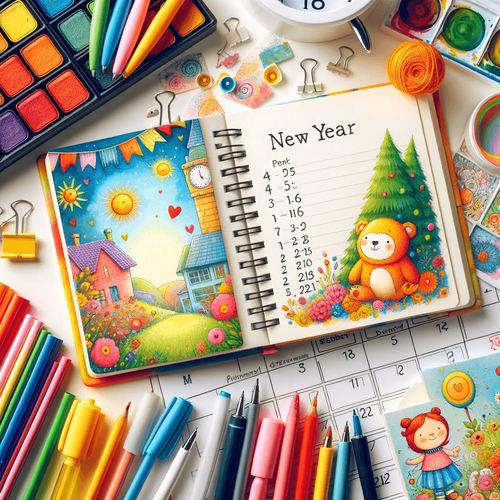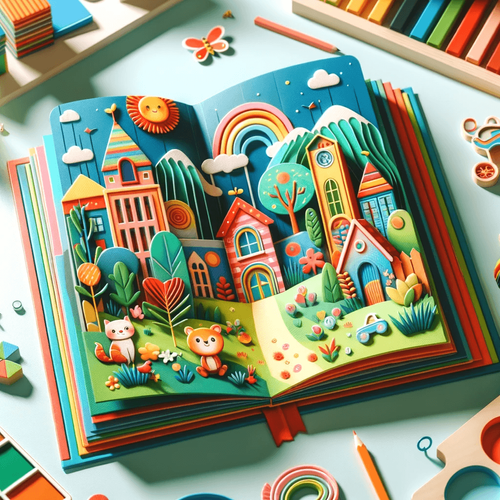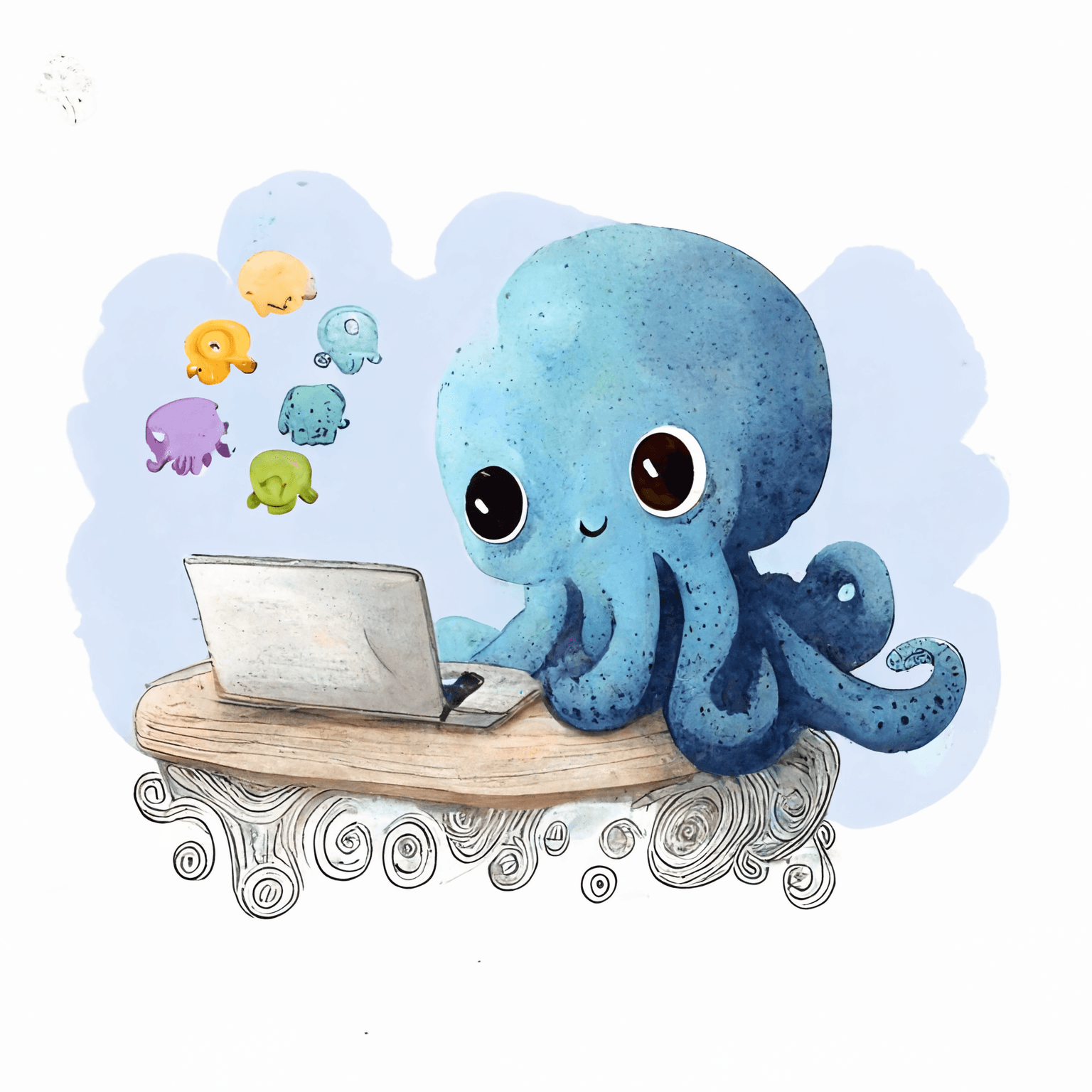When we think of children's literature, the vibrant images that dance across the pages are often the first thing that captures our imagination. Illustrations aren't just decorations; they tell half the story in a children's book, giving life to the words on each page. This guide aims to explore the vast world of illustration styles, helping authors navigate through their options and select the right artistic style for their stories.
Understanding Illustration in Children's Books
Illustrations in children's books do more than just accompany text; they breathe life into stories, engaging young readers and giving visual cues that help in their understanding and enjoyment. The four main categories of illustration—Traditional, Modern Digital, Genre-Specific, and Mixed Media—each offer unique benefits and can set the tone of a book. Key characteristics of children’s book illustrations include their ability to captivate the target audience, complement the narrative, and enhance the thematic elements of the story.
Traditional Illustration Styles - Paint and Drawing
Watercolor
Known for its soft gradients and gentle presentation, watercolor illustrations are ideal for stories that need a touch of whimsy or tenderness. It's particularly effective for fairy tales and bedtime stories, where the fluidity of the watercolors can echo the dreamlike quality of the story.
Watercolor paint is transparent and often layered. The way it is made helps increase the flow of watercolor which creates the transparent washes it is known for. Unlike gouache, watercolor is typically used for painting techniques with a transparent look, and can be layered, using successive layering techniques.
Watercolor is a popular medium for children's book illustrations, as shown below in popular books illustrated by Betsey Lewin, Sophie Blackall, and Tomie dePaola.
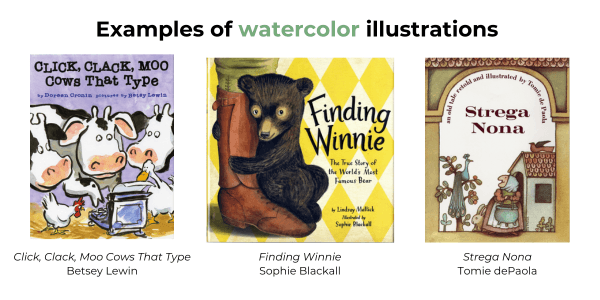
Acrylic and oil paints are often celebrated for their depth of color and dynamic texture. This makes them suitable for bold, adventurous stories because they bring richness and vibrancy to children's book illustrations.
Acrylic
If you want illustrations that are colorful, vibrant and playful, you might want to consider acrylic as your medium. Made of powdered pigment mixed with polymer resin, acrylic is known for its vibrant colors and overall versatility. Many children's book illustrators use it because it comes in a wide variety of colors, it's easy to work with, and it dries quickly. It can also be easily thinned out to achieve a look similar to watercolor, or applied thickly, achieving a similar look and density to oil paint.
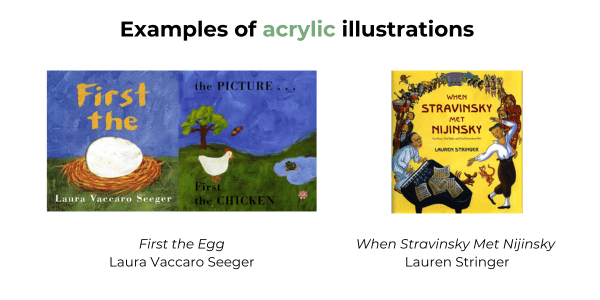
Oil Paint
If you're looking for illustrations that offer a range of colors with the added element of depth and texture, oil paint may be the medium you're looking for. It's highly versatile, allowing artists to create unique shades and hues by mixing different colors together. Oil paint dries slowly, but allows artists to create depth and richness, unlike many other popular mediums.
It is made from a powdered pigment bound in plant-derived oils like linseed or walnut oil. Although oil paint can be used on paper or wooden panels, it is most often used on cotton or linen canvas.
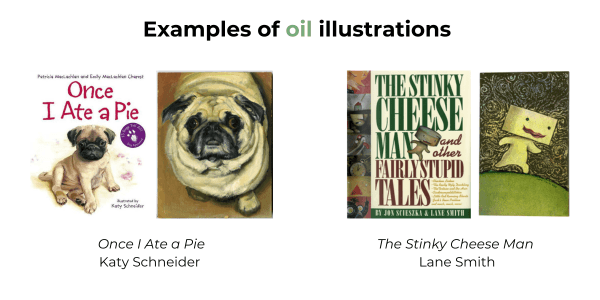
Gouache
Gouache is like a thicker, non-transparent watercolor. Because the pigment load is higher, it offers increased coverage and saturation. Gouche is also available as an acrylic gouache.
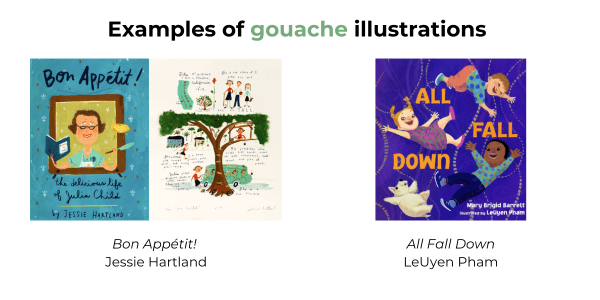
Tempera
Tempera paint is brightly saturated and offers a look that is often associated with "classic" children's books. Because it dries quickly, it's often used for flat blocks of color, similar to the effect you'd see with gouache, rather than being used for painting techniques that require gradiants and transparency. This is the medium used in classic books like The Poky Little Puppy and Goodnight Moon.
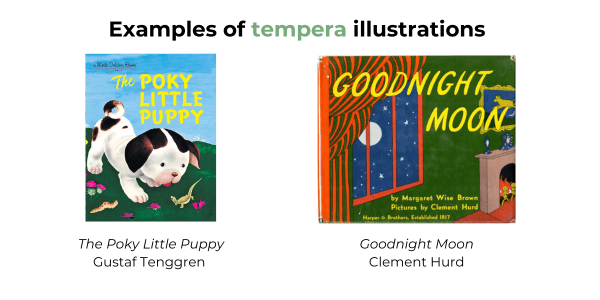
Drawing typically refers to the use of lines to create the forms and figures of an illustration, as opposed to paint, where the illustration is done with blending, smearing, and smudging. Drawing and paint are often used together. Most illustrations that use drawing materials take the form of dry media (think pencils and charcoal), though pen and ink are also used, and not considered "dry".
Many artists and illustrators now use digital art to recreate or get the effects of chalk, pastels, pen, and ink. Drawings are also often scanned and manipulated with computers.
Colored Drawings: Chalk, Pastel, Colored Pencils, and Crayon
In children's book illustrations, the charm and versatility of colored drawing mediums cannot be overstated or ignored. Chalk, colored pencils, crayons, and pastels each bring their own unique texture and depth to the illustrations, allowing for a broad range of artistic expression:
- Chalk give the illustrator the benefits of soft, blendable hues, making them the ideal medium for dreamy backgrounds.
- Colored pencils are an excellent option for detailing and layering colors, especially in intricate and detailed scenes.
- Crayons, with robust and vibrant tones, are perfect if you want to capture the essence of youth and creativity.
- Pastels offer a great balance between painting and drawing, offering a soft, velvety finish that's perfect for stories that need a gentle touch.
Together, these mediums open a playground of possibilities for illustrating children's books, making them among the favorite options for artists and children's book illustrators.
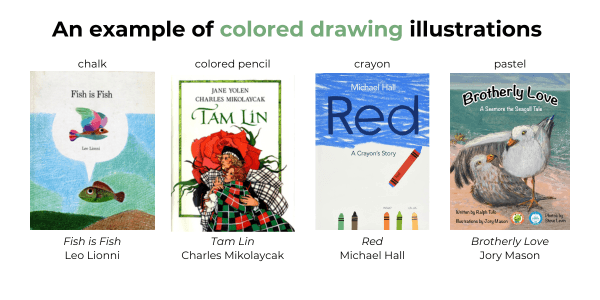
Black and Gray Drawings: Charcoal, Ink, Pencil
Black and grey drawing mediums include charcoal, ink, and pencil. They bring a different dimension to children's book illustrations when compared to colored drawing options. They are known for helping to convey strong emotions, depth, and contrast through the use of shadows, lines, and texture.
- Charcoal offers a range of rich blacks and wide range of greys, making it perfect for creating moody, dark, eerie, and dramatic scenes.
- Ink gives illustrations clean, precise lines and deep, intense blacks, making it ideal for bold illustrations and intricate details.
- Pencils provide a wide range of shades and are an excellent option for detailed work, allowing for fine gradations in tone.
Together, charcoal, ink, and pencil are children's book illustration mediums that can create a sense of nostalgia, focus on storytelling, and evoke a timeless feel in children's books.
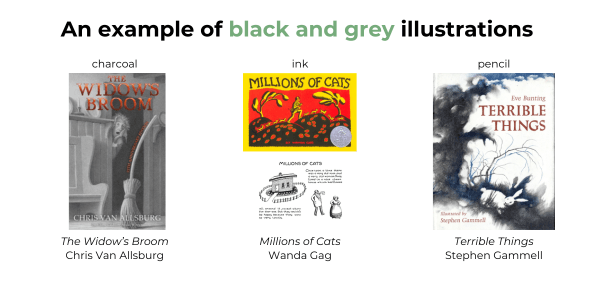
Collage and Mixed Media
Collage and mixed media illustration styles offer a unique and tactile approach to visual storytelling in children's books.
- Collage involves the combination of different tactile materials to create an illustration and is easy to spot. It shows as a layered, 3D illustration, created with items such as paper, fabric, and photographs, to create deeply textured images that pop off the page, encouraging young readers to explore each detail with their eyes and fingers.
- Mixed media, which can also be referred to as multimedia, on the other hand, combines multiple art techniques and materials—using anything from paint and pencil to digital elements—creating an unlimited palette of textures, colors, and forms. This results in unique and captivating illustrations that can help convey complex themes, moods, and settings and a rich visual experience.
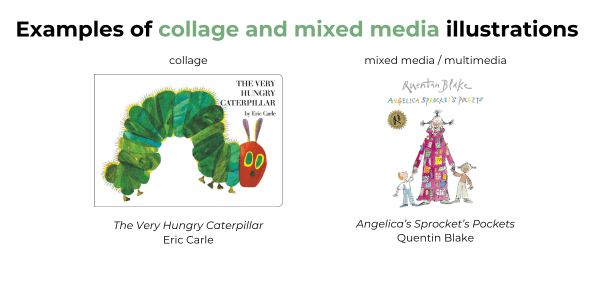
Digital Media Illustration Styles
Digital media is a broad, general term used to describe a range of art and illustrations that use digital technology as an essential part of the creative process. Since the 1970s, we've used different names to describe the process such as computer art, multimedia art, computer enhanced art, computer manipulated art, and digital art.
Digital illustrations are increasingly in popularity in children’s book illustrations. The medium is accessible, incredibly versatile and precise, and often more affordable than traditional art mediums. Digital artwork can now mimic almost any other medium and allows the artist to create and edit highly detailed work in less time. It's suitable for a variety of themes, from realism to fantasy.
Many illustrators who use traditional medium like pencil, pen and ink, paints, and watercolor are now scanning those images and manipulating them with software. This is sometimes referred to as digital and mixed media.
Digital Painting
While there are many different types of digital illustrations, the most common are hand drawn illustrations created with digital tools, like a tablet. Due to it's digital nature, digital painting can be adapted to almost any other type of style, meaning it can be used to mimic just about any illustration or artistic medium.
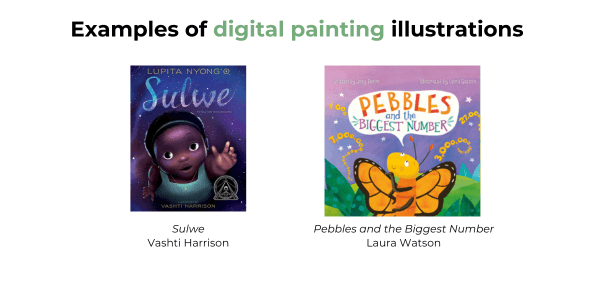
Vector Art
Characterized by its clean lines and scalability, vector art is ideal for educational books or stories that require a clear, concise visual style. Vector art typically takes on a flat, 3D look. Vector illustrations are easy to adjust and resize while maintain their resolution - no matter how large your file. You can expand the size of your illustration to virtually any size, and it will still have an amazing, crisp edge, making it a practical choice for illustrators.
Vector illustrations are most commonly created in Adobe Illustrator or Adobe Animate.
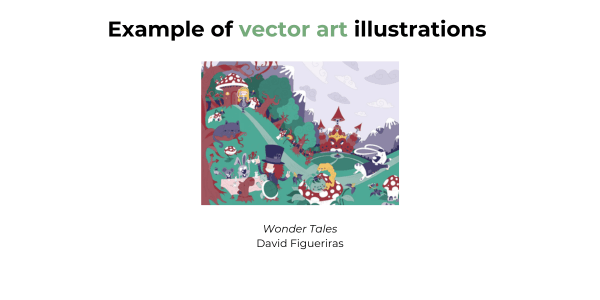
Genre-Specific Styles
Certain illustration styles naturally lend themselves to specific genres. Fantasy stories come alive with whimsical or fantastical illustrations, while educational books benefit from clear, informative visuals. Choosing a style that aligns with the genre not only enhances the storytelling but also ensures that the illustrations resonate with the intended audience.
How to Choose Your Illustration Style
As tempted as you may be to simply pick an illustration style you like and go with it, there are implications to different art styles you should consider, including the theme of your story, the age group of your target audience, your budget, and your personal preferences. Collaborating closely with your illustrator and clearly communicating your vision can help achieve a style that truly complements your narrative.
Traditional Illustrations vs. Digital Illustrations
Illustrations for children's books can be created using traditional methods and art mediums, digitally, or a combination of the two. These days it can be difficult to differentiate between them as the digital tools used can easily copy the art created with traditional tools. That said, digital illustrations do not devalue your children's book or make the art any less "real" than the art created with more traditional tools. Let's take a look at how traditional and digital art can be used in illustrated children's books.
Traditional Illustration
Traditional artists uses mediums such as as paints, pens, pencils, and markers to create your illustrations. Once illustrations have been completed, the images are either photographed professionally or scanned and uploaded to software to add it to the page. Of course, there are pros and cons to using traditional illustrations - they can be much more time-consuming to produce, and may cost more than digital illustrations; however, they do produce beautiful images for children's books. One major downside of traditional illustration is that once your images have been created, they cannot be changed, so it is especially important to carefully review early sketches before you approve the artist to proceed with the final art work.
Digital Illustration
Children's book illustrations can be created by artists using a computer or tablet with programs like Adobe Illustrator or Procreate. Since creating this type of illustration typically takes less time to produce, it is often less expensive - making it a preferred illustration method for many children's book authors.
One of the key benefits to digital illustrations, besides their affordability, is how easy it is to make changes, as needed. With the click of a mouse your artist can move or redraw lines, change colors, or make any other adjustments you request. Digital files also allow for layering files, meaning the artist can separate one element of the image from another, making it not only easy to move them, but to reuse specific elements from an illustration within your marketing materials.
A Word of Caution
While finding the right fit for your children's book illustrations, it's important to always consider the impact that the visual quality will have on the reader's experience. Low-quality clip art style illustrations, though inexpensive, can significantly take away from the magic of even the most well-written books. Clip-art style illustrations lack the depth, emotion, and uniqueness that bespoke artwork brings to a narrative. They can appear generic, flat, and disconnected from the text, which can undermine the story's ability to fully engage its audience.
In a market where the visual presentation of a book plays a crucial role in attracting young readers and their caregivers, opting for inexpensive clip art can convey a lack of investment in your story's overall quality. As a result, I encourage you to weigh the long-term benefits of investing in higher-quality, original illustrations that resonate with readers and elevate the storytelling experience, ensuring that the book stands out in a crowded marketplace.
Formatting and Its Impact on Illustration Styles
Children's picture books generally use four main types of illustrations, all which will directly impact your illustration style for that page or spread:
- spot art - also sometimes called a spot illustration, is a standalone piece of character art, typically without a background behind it. They're typically used to draw attention to a character when the illustrator needs to zoom in a certain emotion or action, but rarely shows more around the character.
- vignettes - are small scenes on a page. They're often used in groups to show more than one scene playing out at a time, most frequently when you're illustrating a series of actions shown one after another. This gives some breathing room and white space to a page that a full-bleed illustration cannot, and allows the illustrator to combine multiple moments of a story onto one page.
- full bleed illustrations (single page) - is an illustration that fills the entire page, falling into the safety margins and bleeds of the book. They often have fully illustrated backgrounds and are often used to illustrate a moment in a story that needs to be highlighted.
- full-bleed spreads - take up two full pages of the book, on opposing sides of the fold. They're usually used in children's books to show the most important moments of the book or parts of the story that really need to stand out from the rest of the book. When considering if a full-bleed spread is required, think about whether the scene you're trying to convey is worthy of such attention or if the decision is only being made to help with pagination.
Hiring a Children's Book Illustrator
Before you hire an illustrator for your children's book, you want to make sure you have a solid understanding of the art style you want, what type of illustrations you will need, and how many illustrations you will need. These details are not only necessary to evaluate potential illustrators, but so the illustrator to provide an accurate estimate of final costs. Don't forget to look closely at illustrator portfolios and don't be afraid to ask for sample illustrations before you make any final decisions or sign any contracts!
Not Sure Where to Start?
Take inspiration from what has already been published! Take a trip to your local book store or public library to explore the range of children's books and their illustrations. This can spark inspiration and help you visualize the potential of different styles and the impact they could have on your book.
You'll no doubt find yourself drawn to certain art styles - what do they have in common? Pay attention the colors used, think about what medium may have been used, and most importantly, consider if something similar would be the right fit for your unique book.
Final Words
The journey to selecting the perfect illustration style for your children's book is both creative and introspective. By understanding the various styles available and considering how they align with your story and audience, you can create a visually stunning book that captures the hearts and imaginations of young readers. Remember, the right illustrations do more than complement your narrative; they elevate it, creating a memorable experience for everyone who turns the pages.
Related Articles
Dive deeper into the world of children's literature with our collection of insightful articles. Whether you're seeking inspiration, guidance on illustrations, or strategies to engage your young readers, our expertly curated content is here to support your journey as an author. Explore the following resources to enhance your knowledge and skills in creating memorable children's books:
- Understanding Your Audience: Delve into the nuances of your target age group and preferences to ensure your illustrations resonate with your intended readers. Read More
- Themes in Children’s Books: Learn how to select compelling themes and visually represent them to captivate young minds. Read More
- The Illustration Process: Uncover the key stages of transforming your initial concept into stunning final artwork, emphasizing effective author-illustrator collaboration. Coming soon.
- Current Trends in Illustration: Stay ahead with insights into the latest trends and what makes children's book illustrations stand out in today’s market. Coming soon.
- Tools for Illustrators: Compare traditional and digital illustration tools to find the right equipment for your artistic journey. Coming soon.
- Budgeting for Illustrations: Navigate the financial aspects of creating illustrations, from understanding costs to effective budgeting strategies. Coming soon.
- Hiring Illustrators: Essential tips for finding the right illustrator, fostering a successful collaboration, and understanding contractual nuances. Coming soon.
- Legal Considerations: Safeguard your creative work with a comprehensive overview of copyright laws relevant to authors and illustrators. Coming soon.
- Case Studies/Success Stories: Be inspired by success stories and learn from the experiences of successful children’s book authors and illustrators. Coming soon.
- Marketing and Promotion: Utilize your book’s illustrations to enhance marketing efforts and engage potential readers through creative promotional strategies. Coming soon.
- Diversity and Representation: Embrace inclusivity by ensuring your illustrations reflect the diversity of the world around us. Coming soon.
- Feedback and Testing: Understand the importance of receiving feedback on your illustrations and learn methods for testing them with your target audience. Coming soon.
To all aspiring and seasoned authors of children's books, your journey to connecting with the right audience begins here. Dive deeper into crafting stories that resonate, captivate, and educate by exploring Made Live. Our platform is designed to empower authors like you, offering an end-to-end self-publishing solution tailored specifically for illustrated books. Whether you're looking to enchant with picture books or captivate with young adult novels, Made Live provides the tools and support you need to bring your stories to life.
Start your journey with us today by signing up for a free trial at Made Live. Let's transform your vision into the next beloved children's book together.

